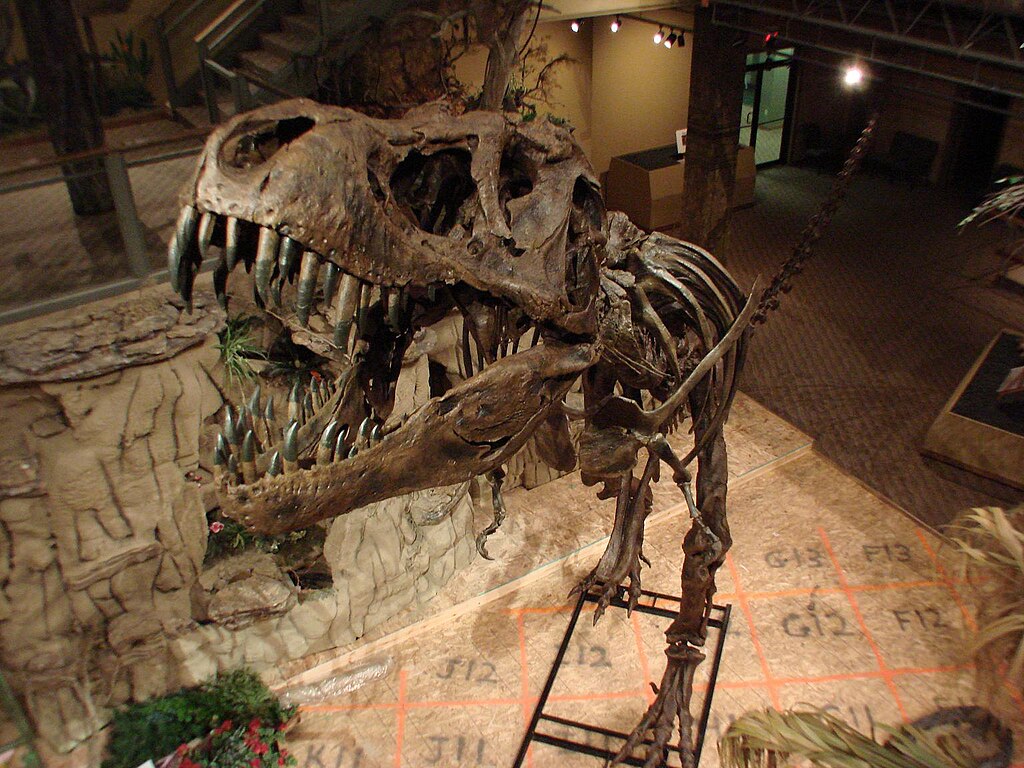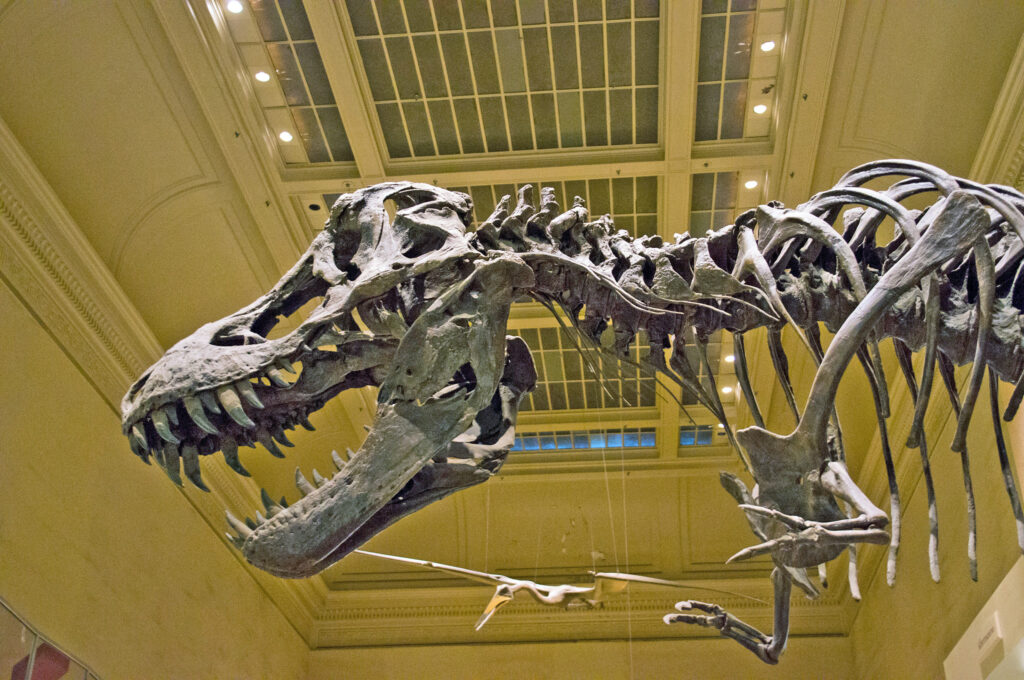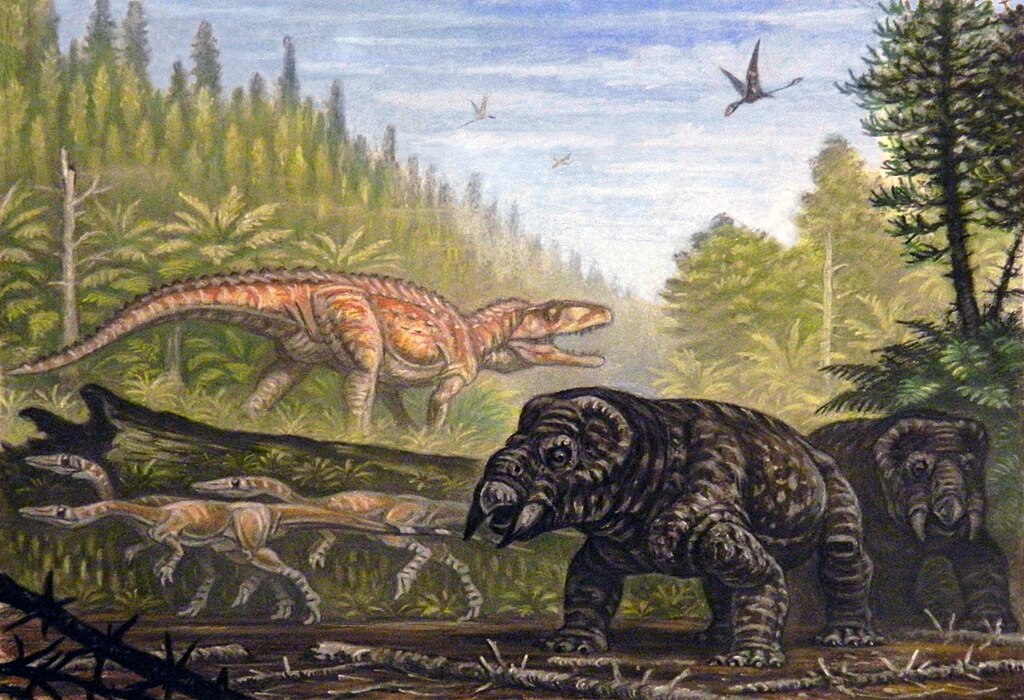The Tyrannosaurus rex holds an unrivaled position in both scientific importance and popular imagination as the ultimate prehistoric predator. Among the various T. rex specimens discovered throughout history, one stands out for its exceptional completeness and preservation quality. This remarkable fossil, known as “Sue,” represents the pinnacle of paleontological discovery and offers invaluable insights into the anatomy and life of these fascinating creatures that roamed the Earth approximately 67 million years ago. The discovery, excavation, and exhibition of the world’s most complete T. rex skeleton is a remarkable story that combines scientific achievement, legal battles, and the enduring human fascination with dinosaurs. This article explores where you can see this extraordinary specimen and what makes it so scientifically significant.
The Discovery of Sue: A Paleontological Milestone

On the morning of August 12, 1990, paleontologist Sue Hendrickson made a discovery that would reshape our understanding of Tyrannosaurus rex. While exploring a cliff face on the Cheyenne River Indian Reservation in South Dakota, Hendrickson noticed several large vertebrae protruding from the eroded hillside. This chance discovery led to the unearthing of what would become known as “Sue,” named after its discoverer. The fossil was remarkable not only for its size but for its unprecedented completeness—approximately 90% of the original skeleton was recovered, making it the most complete T. rex specimen ever found at that time. The skeleton included previously unknown elements of T. rex anatomy and provided paleontologists with an unprecedented opportunity to study this iconic dinosaur in extraordinary detail. Sue’s discovery marked a watershed moment in paleontological history, offering researchers a nearly complete blueprint of T. rex anatomy.
The Legal Battle for Sue’s Ownership

What should have been a straightforward scientific discovery quickly escalated into one of paleontology’s most complex legal battles. Shortly after Sue’s excavation, the FBI and National Guard seized the fossil, initiating a prolonged ownership dispute that would last for years. The central question revolved around whether the fossil belonged to the landowner, Maurice Williams, the Cheyenne River Sioux Tribe on whose reservation it was found, or to Peter Larson’s Black Hills Institute, which had conducted the excavation. The case involved multiple federal agencies, tribal authorities, and even resulted in criminal charges related to fossil collection practices. After lengthy court proceedings, the federal court determined that Sue belonged to Williams, as the land was held in trust by the federal government. In September 1997, the fossil was put up for auction at Sotheby’s in New York, ultimately selling for an unprecedented $8.36 million—the highest amount ever paid for a fossil at that time. The buyer, to many people’s surprise and relief, was the Field Museum of Natural History in Chicago, with financial backing from Disney and McDonald’s.
Sue at the Field Museum: A Permanent Home

Following its acquisition, Sue found a permanent home at the Field Museum of Natural History in Chicago, where it was unveiled to the public on May 17, 2000, after more than 30,000 hours of preparation work. The museum created a special exhibition hall specifically designed to showcase this exceptional specimen, allowing visitors to experience the massive dinosaur from multiple viewing angles. The initial installation featured Sue’s skeleton mounted with its arms close to its body, reflecting the scientific understanding at that time. However, in 2018, Sue underwent a significant remounting based on updated research, moving to a dedicated exhibition space called “Griffin Halls of Evolving Planet.” This updated mount incorporates new scientific findings about T. rex posture and anatomy, including a revised positioning of the arms and the addition of gastralia (belly ribs) that had not been initially displayed. Today, Sue remains the centerpiece of the Field Museum’s dinosaur collection, attracting millions of visitors annually who come to marvel at the most complete T. rex ever discovered.
Scientific Significance of Sue’s Completeness

Sue’s exceptional completeness, with approximately 90% of the skeleton recovered, has made it an invaluable scientific resource that continues to yield new insights decades after its discovery. The specimen includes 250 of the approximately 380 bones that would have made up a complete T. rex skeleton, including rarely preserved elements such as a furcula (wishbone), sternal ribs, and a nearly complete set of gastralia (belly ribs). This level of completeness has allowed scientists to study T. rex anatomy with unprecedented precision, leading to improved understanding of its muscle attachments, range of motion, and overall body structure. Sue’s skull, recovered in numerous fragments, has been particularly informative despite being too heavy for mounting with the skeleton (a lightweight cast is used for display). CT scans of the actual skull have revealed details about brain structure, sensory capabilities, and bite mechanics that would have been impossible to study with less complete specimens. Additionally, pathologies visible in Sue’s bones—including healed broken ribs, leg bones, and vertebrae—provide rare glimpses into the life history and survival challenges faced by this individual animal.
Sue’s Size and Physical Characteristics

Sue stands as one of the largest and most robust T. rex specimens ever discovered, measuring approximately 40 feet (12.3 meters) in length and standing 13 feet (4 meters) tall at the hip. When alive, this massive predator would have weighed approximately 9 tons (8,160 kilograms), making it one of the most massive terrestrial predators known to have existed. The skull alone measures 5 feet (1.5 meters) in length and could exert a bite force estimated at more than 6,000 pounds of pressure, capable of crushing bone. Analysis of Sue’s skeleton has revealed fascinating insights into T. rex anatomy, including confirming the relatively small forelimbs that have become an iconic feature of this dinosaur. The completeness of the specimen has allowed researchers to accurately determine proportions and growth patterns that were previously based on composite estimates from multiple incomplete specimens. Perhaps most notably, Sue exhibits several physical characteristics suggesting it was a robust individual, l—with thick bones and pronounced muscle attachment sites indicating powerful musculature throughout its body. These features have helped paleontologists better understand how T. rex’s physical build contributed to its success as an apex predator in its ecosystem.
Age and Life History of Sue

Detailed analysis of Sue’s skeleton has provided remarkable insights into the life history of this particular T. rex, with scientists determining it was approximately 28 years old at death, making it one of the oldest known T. rex specimens. This age assessment was made through histological examination of bone tissue, where growth rings similar to those in trees reveal annual growth patterns. Sue’s bones show evidence of a life filled with challenges and survival, including several major injuries that had healed before death. The skeleton bears signs of broken ribs, a broken arm, and infections in the jaw that would have caused significant pain and difficulty feeding. Most notably, several vertebrae show signs of infection that may have been caused by parasites similar to those that affect modern birds. These pathologies tell the story of an animal that survived numerous injuries and illnesses throughout its nearly three-decade life, providing a rare glimpse into the resilience and hardiness of Tyrannosaurus rex. Sue’s advanced age also contributes valuable data to our understanding of T. rex growth rates and lifespan, suggesting these animals could potentially live even longer under favorable conditions.
Visiting Sue: The Exhibition Experience

Visiting Sue at the Field Museum offers an unparalleled opportunity to stand in the presence of prehistoric greatness, with the exhibition designed to maximize the educational and emotional impact of encountering this magnificent specimen. The current installation in the “Griffin Halls of Evolving Planet” presents Sue in a scientifically accurate posture within a recreated Late Cretaceous environment, helping visitors contextualize the animal in its natural habitat. Interactive displays surrounding the skeleton provide information about Sue’s discovery, biology, and significance, including touchable casts of selected bones that allow visitors to connect physically with the exhibit. The museum offers guided tours focusing specifically on Sue, providing deeper insights into the specimen’s scientific importance and the dramatic story of its discovery and acquisition. For those seeking a comprehensive experience, the Field Museum’s “SUE Discovery Squad” mobile application provides an augmented reality experience that brings the skeleton to life, showing how muscles and skin would have appeared on the frame visitors see before them. The exhibit is deliberately designed to appeal to visitors of all ages, combining rigorous science with the inherent wonder that dinosaurs inspire in children and adults alike.
Beyond Chicago: Sue’s Traveling Cast

While the original Sue skeleton remains permanently housed at the Field Museum in Chicago, the museum has created extremely detailed casts of the entire skeleton that have traveled to museums worldwide, extending Sue’s educational reach to millions of additional visitors. These traveling exhibitions, typically titled “A T. rex Named Sue,” feature full-sized replica skeletons created through a painstaking molding and casting process that captures details down to the microscopic level. The touring exhibition has visited more than 100 venues across the globe, including major natural history museums, science centers, and educational institutions in North America, Asia, Europe, and Australia. Each installation includes educational materials about Sue’s discovery, scientific significance, and what the specimen has taught us about T. rex biology and behavior. For many visitors unable to travel to Chicago, these touring exhibitions provide their only opportunity to appreciate the scale and completeness of this remarkable specimen. The Field Museum continues to manage these traveling exhibitions as part of its educational mission, updating the scientific information presented alongside the casts as new research emerges from ongoing studies of the original specimens.
Other Notable T. Rex Specimens Around the World

While Sue remains the most famous and was long considered the most complete T. rex, several other notable specimens have been discovered that offer fascinating comparisons for dinosaur enthusiasts. “Stan,” discovered in South Dakota in 1987, was approximately 70% complete and was displayed at the Black Hills Institute before being controversially sold at auction in 2020 for $31.8 million to an undisclosed buyer, later revealed to be heading to a new natural history museum in Abu Dhabi. “Scotty,” discovered in Saskatchewan, Canada, is potentially larger than Sue and has been described as possibly the largest T. rex ever found, though it is less complete at about 65% of the skeleton. In 2018, the “Trix” specimen, approximately 80% complete, found a permanent home at the Naturalis Biodiversity Center in Leiden, Netherlands, making it the only original T. rex skeleton permanently housed in Europe. Most recently, “FMNH PR 2081” (nicknamed “Máximo”) at the Field Museum represents a composite cast of several T. rex specimens, mounted to demonstrate the latest scientific understanding of T. rex posture and anatomy. Each of these specimens contributes unique data to our collective understanding of Tyrannosaurus rex, with varying degrees of completeness, preservation quality, and scientific accessibility.
Scientific Research Enabled by Sue

Sue’s extraordinary completeness has enabled numerous groundbreaking scientific studies that continue to reshape our understanding of Tyrannosaurus rex biology and behavior. Using advanced imaging techniques like computed tomography (CT) scanning, researchers have created detailed three-dimensional models of Sue’s skull, revealing previously unknown aspects of brain structure, sensory capabilities, and bite mechanics. These studies have suggested that T. rex had an exceptional sense of smell and hearing, while also confirming its devastating bite force through biomechanical modeling. Histological examination of thin sections of Sue’s bones has provided unprecedented insights into growth rates, suggesting that T. rex experienced rapid growth during adolescence before slowing considerably as it approached adulthood. The pathologies visible throughout Sue’s skeleton—including healed injuries and evidence of infections—have spawned research into T. rex’s immune response and healing capabilities, with implications for understanding dinosaur physiology more broadly. Perhaps most significantly, the completeness of Sue’s skeletal elements has allowed for more accurate reconstructions of muscle attachments, enabling scientists to better estimate the strength, speed, and agility of this iconic predator. Each year, researchers continue to publish new findings based on examinations of Sue, demonstrating the enduring scientific value of this exceptional specimen.
The Cultural Impact of Sue

Beyond its scientific significance, Sue has become a genuine cultural icon, transcending the boundaries of paleontology to become a recognizable symbol in popular culture. The Field Museum has embraced Sue’s popularity, creating a whimsical social media presence for the specimen that includes a Twitter account with over 50,000 followers featuring humorous, first-person posts written from Sue’s perspective. This personification has helped humanize science and make paleontology more accessible to broader audiences. Sue has appeared in numerous documentaries, books, and educational programs, serving as an ambassador for dinosaur science to generations of children who often form their first connection to natural history through dinosaurs. The dramatic story of Sue’s discovery, the legal battles over ownership, and the record-setting auction have become the subject of books, films, and museum exhibitions in their own right. Even in merchandise, Sue stands out—the Field Museum gift shop offers everything from scientifically accurate models to plush toys and clothing featuring the famous T. rex. This cultural prominence has elevated Sue beyond being merely a scientific specimen to becoming a symbol of both natural history and the human fascination with the prehistoric world.
Recent Discoveries: Is Sue Still the Most Complete?

Since Sue’s discovery in 1990, paleontology has continued to advance with new T. rex specimens challenging its status as the most complete. In 2016, a T. rex specimen nicknamed “Titus” was discovered in Montana with claims of potentially exceeding Sue’s completeness, though final preparation and scientific description are still ongoing. More definitively, in 2018, “Tristan Otto,” discovered in Montana and currently housed in the Museum für Naturkunde in Berlin, was reported to be 170 bones (about 55% complete) but includes exceptionally well-preserved elements not found in other specimens. Most significantly, a specimen nicknamed “Trix,” discovered in Montana in 2013 and now displayed at the Naturalis Biodiversity Center in the Netherlands, has been described by some researchers as possibly more complete than Sue in terms of the percentage of skeletal volume preserved, though Sue still retains more individual bones. In 2020, the announcement of “Victoria,” another remarkably complete specimen, added to the growing list of significant T. rex discoveries. Despite these impressive new finds, Sue generally maintains its status as the most complete in terms of both the number of bones recovered and the percentage of the skeleton preserved, though the exact metrics for “completeness” continue to be debated among paleontologists who may emphasize different aspects of preservation quality.
Planning Your Visit to See Sue

For dinosaur enthusiasts planning a pilgrimage to see Sue, the Field Museum of Natural History offers several ways to optimize your experience with this prehistoric celebrity. The museum is located in Chicago’s Museum Campus on South Lake Shore Drive, easily accessible via public transportation or by car with parking available in nearby lots and garages. General admission tickets provide access to Sue’s exhibition, though it’s advisable to check the museum website for current hours, admission prices, and any special exhibitions or events featuring the famous T. rex. Photography is permitted throughout the museum, allowing visitors to capture their encounter with Sue, though flash photography is prohibited to protect the specimens. For those seeking a more in-depth experience, the Field Museum offers behind-the-scenes tours that sometimes include visits to research areas where scientists continue to study elements of Sue not on public display. Families with children should note that the museum provides Sue-themed educational programming and hands-on activities that change seasonally. To avoid the largest crowds, weekday visits, particularly in the morning or late afternoon, typically offer a more relaxed viewing experience with better opportunities to appreciate the specimen from multiple angles and spend time with the interactive educational displays surrounding the skeleton.
Conclusion

Sue the T. rex remains one of paleontology’s greatest treasures and most significant discoveries. Its exceptional completeness continues to provide scientists with invaluable data about T. rex anatomy, physiology, and life history. While newer discoveries occasionally challenge its status as the most complete specimen, Sue’s scientific and cultural impact remains unmatched. For dinosaur enthusiasts and casual visitors alike, seeing Sue at Chicago’s Field Museum offers a profound connection to our planet’s distant past and the magnificent creatures that once ruled it. Whether you experience the original in Chicago or one of the traveling casts exhibited worldwide, encountering Sue provides a tangible link to the prehistoric world and represents one of the most impressive scientific and curatorial achievements in natural history.



